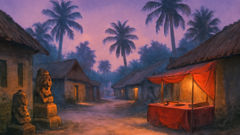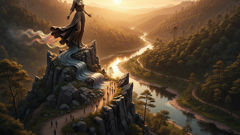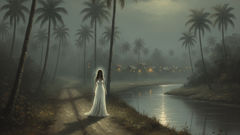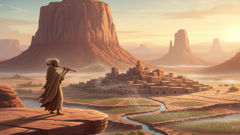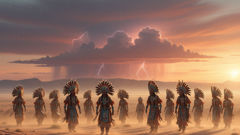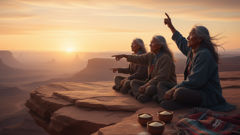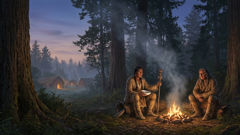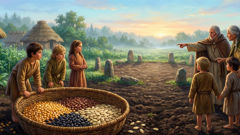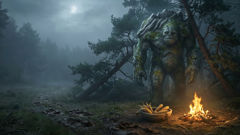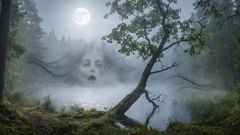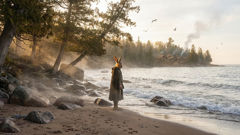Introduction
At the edge of dusk, when the air remembers the scent of rain and ash from a hundred fires, Eshu walks the line between road and ramble, between chance and choice. He wears a veil of dust and a smile that knows the names of every creature that lives in the shadow of a palm leaf. The crossroads, in Yoruba belief, is not merely a physical junction but a spiritual hinge where paths touch time and a single decision can tilt a life in a new direction. In this story Eshu does not merely appear; he becomes the turning wind that shuffles the leaves of fate, the whisper that makes a stubborn choice tremble, the joke that cracks the shell of fear so a seed of wisdom can sprout. He visits families at night and merchants at noon, old grandmothers grinding pepper and young boys learning to read the map of a world that folds and unfolds with a nod, a wink, and a wager. This introduction invites you to walk with him in a land where language is currency and every proverb is a doorway, where the simplest question may unmask a truth that hurts and heals in equal measure. Eshu is not a figment; he is the breath you take before you decide whether to stay or to leap. And in his breath lives the memory of a people who learned, century by century, to listen to the laugh of the trickster and keep a steady heart.
At the Crossroads, Eshu’s First Whispers
The first whisper comes not with a decree but with a rattle of dried beads, a small whistle from a neck of beads that lies on a wooden table. Eshu does not stride in like a general; he slides in like a breeze that knows exactly where a door is hidden. The people of the village notice him not because he announces himself with a flame but because he leans into the ordinary moment and makes it glow with a question: Which path will you choose when two shadows fall on the same road at twilight? He travels with a bag that is never heavy but full of possibilities: a coin that never settles on a single face, a drum that seems to speak in syllables you know you should fear, a rope that can either become a lasso or a tether to the ground of your own hesitation. The traders at the market test him with a bargain and he tests them with a riddle. A boy tries to win a kite by giving all his savings to a stranger; a grandmother counts her steps toward the house that holds her husband’s memory. Eshu smiles and lets them think they own the world for a breath, only to teach them that ownership is a test of listening as much as it is a struggle for surplus. The road is a living thing, he tells them, and every breath you take is a coin asked for in exchange for your future, a future that is never a guarantee but always a gift you may either spend or save for the better moment you cannot yet imagine. The lessons arrive as small, patient puzzles: a mother who cannot decide whether to forgive a quarrel that seems to repeat itself like a drumbeat; a farmer tempted to abandon his field because luck seems to have forgotten him; a craftsman who chases a perfect line and forgets to mark the edge where his work touches another life. Eshu’s trickery never insults the gods; it invites them to dance. He moves the thread that binds opportunity to each person’s willingness to reach for it. In those first whispers the village learns what all crossroads teach: the difference between a choice that serves the self and a choice that serves the many. The night grows taller around the voices, and when dawn reaches the corners of the market square, the people realize that the trickster did not demand obedience; he asked for a careful listening so that the right decision could emerge from a chorus of possible paths. The lesson is simple, and it is not. It is the forest of options and the quiet echo of responsibility that follows: listen first, then decide, and if the choice proves to be a misstep, let the step be a lesson, not a punishment. Eshu leaves a thread on every doorpost that says, in effect, you have the agency to choose how your story will unfold, but the price of that agency is attention, honesty, and courage to face the consequences of your selection. The whisper lingers long after he vanishes into the dust of the road, and the people begin to test their answers against the night themselves, learning that sometimes the right path looks wrong until the dawn reveals the proof of its necessity.
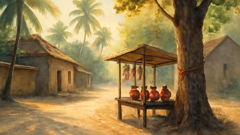
Wisdom Woven through Trickery
In the second section the trickster returns not with a grand parade but with a handful of ordinary moments glazed with mischief. Eshu asks a hunter to place a trap for a rabbit that is rumored to be cleverer than most men and women who boast of their skill. The trap is cunningly simple: a loop of vine laid across a path that would make the rabbit pause to listen to its own heartbeat. The hunter thinks he will outsmart the world by forcing chance to bow to his will. Eshu, watching from the edge of the clearing, lets the hunter’s pride unfurl until pride itself becomes a mirror that reveals a different shape: the hunter who cannot hear the forest because he is listening only to the echo of his own voice. The forest answers in a language of small signs—the rustle of leaves not for a rabbit but for a student—a child who learns to read the whispers of the wind and to sense the unseen door inside a tree trunk where a wiser choice might be hidden. A trader arrives with tins of palm oil and a rumor of drought. He offers a bargain to swap his harvest for a promise of rain that never lands in his hand. Eshu does not scold him; he redirects him with a story about rivers that remember every footstep that passed by them. The trader discovers that wealth, when measured only in coins and weights, grows pale beside the wealth of trust and timely mercy. The crossroad gives every man and woman a chance to practice listening as a form of courage. Eshu’s trick is not to humiliate but to confirm a truth: a life built on deceit is a life built on a cliff edge, and every bridge that begins in a lie ends in a fall. Yet even in punishment there is laughter, and in laughter there is a seed of reform. The trickster teaches that sometimes the most daring act is not a bold strike but a patient pause—the pause that allows a neighbor to tell the truth that the loudest trumpet had drowned out. When the sun climbs again, he offers a gift not of gold but of a new way to see: a field can be a map, a map can be a field, and every field may become a school where the lesson is the same: you must know what you are willing to risk, and you must know what you are willing to sacrifice for the good you hope to achieve. This is the heart of Eshu’s method: he chooses not to dictate the outcome but to refine the maker of outcomes—humans who will carry the memory of his questions into every decision they face in the future.
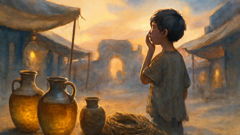
The Night of the Gatekeeper's Song
The final act unfolds not with a single triumph but with a chorus. Eshu returns to the temple gate where the elders gather to seal agreements between the living and the ancestors, a threshold where words carry weight heavier than iron. He challenges the gatekeeper to sing a song that makes the doors open not to those who knock hardest but to those whose hearts align with the truth they carry inside. The gatekeeper’s own story, a thread of sorrow and hope, becomes the key that unlocks a ritual space for strangers who arrive with questions in their pockets and mercy in their hands. The Trickster does not erase pain; he reframes it as a teacher wearing a mask. A family broken by a cycle of resentment discovers a new way to speak: they quit building walls and start building bridges, listening first for the voice of apology, then for the courage to act on it. Eshu dances between pulses of firelight and the cool breath of the night air, guiding the dancers through steps that seem to bend time but actually reveal it to be a patient ally. A young woman who fears that her dreams are larger than the village can bear is given a path not of escape but of invitation: a village that grows by inviting the larger world in rather than baring its teeth to push it away. Eshu’s final trick is a map drawn in the air with no ink, showing that the only true crossroads are those inside a person’s heart: the moment when you decide to forgive, to begin again, or to take a road that leads to new listening. By dawn, the town understands that the trickster does not want followers but founders—people who will mark their own journeys with care, humor, and fidelity to their neighbors. The crossroads remain, the lessons deepen, and the road becomes a living archive in which every new decision is a line added to a larger story that includes all who walked before and all who will walk after.
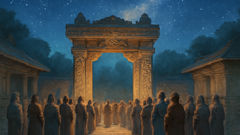
Conclusion
And so the road keeps teaching. Eshu does not vanish; he dissolves into the listening breath that follows a choice: the moment you decide what news you will carry into tomorrow, you become a keeper of the crossroads. To live well is to balance chance with responsibility, wit with humility, and laughter with mercy. The elders say that wisdom is a river: it runs through each of us, and the trickster is the current that keeps it moving. If you ask what Eshu wants from you, the answer is both simple and not: be present to your choices, tell the truth, and leave room for mercy. For if you can do these things, the moments at the crossroads stop being tests and become opportunities to become brave, to heal what seems broken, and to glimpse a future where many paths can lead to a shared, wiser road.

